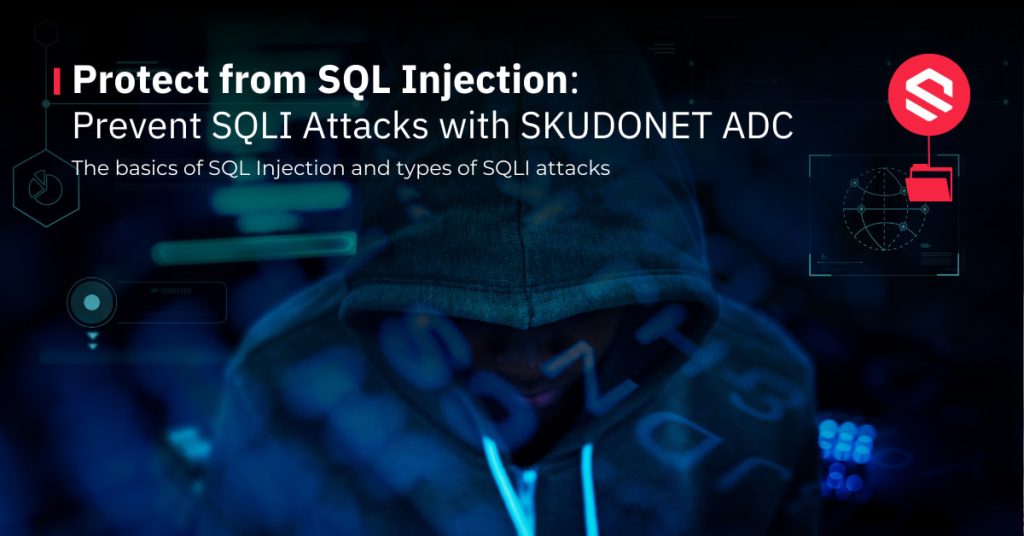Protect from SQL Injection attacks with SKUDONET ADC
SQL Injection attacks can be detrimental to the security of your data and network integrity. Understanding how these attacks work is crucial in order to protect your systems.
In this article, we will explore the basics of SQL Injection and the various types. We will also discuss common vulnerabilities that make systems susceptible to these attacks.
Additionally, we will delve into prevention methods such as input filtering, parameterized SQL database queries, and stored procedures. Assessing vulnerabilities and implementing proper protection measures are essential to safeguard against potential threats.
SEE Video configure SKUDONET ADC to Protect from SQL Injection Attacks
Stay tuned for more insights on protecting your systems from this serious security risk.
Contents
Understanding SQLI Attacks
The Basics of a SQL Injection attack
SQL Injection are malicious attacks that exploits vulnerabilities in a web application’s database interaction to gain unauthorized access or manipulate sensitive data from database. Attackers inject malicious SQL code into input fields, taking advantage of poor validation and concatenation practices.
A SQL Injection Example would be to use a web form to execute a user query with no validation against the database. Another example would be a login form (with username and password), with fields that allow users and database administrators to access to a web application. The SQL Injection occurs when a malicious user uses the input fields with prepared statements and with parameterized queries and execute that query. Often the web application firewall is not properly configured and allows the execution of such a query. Another example would be an application that uses a database for example to retrieve information or grant access to a web server where a hackers can insert query statements and stored data.
Types of SQLI Attacks
There are various types of SQLI attacks, but the most common types are:
- Classic SQL Injection: Attackers insert malicious SQL statements into vulnerable input fields.
- Blind SQL Injection: Attackers exploit boolean-based or time-based blind SQL injection techniques to extract personally identifiable information from the database.
- Error-based SQL Injection: Attackers leverage error messages to gather information about the database structure.
- Union-based SQL Injection: Attackers manipulate the query using the UNION operator to combine results from different database tables.
SQL Injection Vulnerability
SQL Injection often arise due to:
- Lack of input validation and sanitization: Failure to validate and sanitize user supplied input can allow untrusted data to be included into the SQL database queries.
- Improper use of escape characters: Inadequate handling of special characters can lead to unintended SQL code execution.
- Insufficient privilege separation: Insufficient separation of database privileges may allow attackers to abuse their access.
By understanding the basics of SQL Injection attacks, the types that may occur, and the common weaknesses associated with them, organizations are able to take necessary measures to protect their systems and data from potential intrusions.

Preventing SQL Injection
Protecting from SQL Injection requires implementing effective preventive measures throughout the application development process. By following these best practices, you can significantly reduce the risk and protect from SQL Injection attacks.
Input Filtering and Validation
Proper input filtering and validation play a crucial role in SQL Injection prevention. Validate and sanitize user inputs to ensure they adhere to the expected format, length, and data type. Implement input validation at both the client-side and server-side to defend against malicious attack attempts.
In addition, consider implementing a whitelist approach where only specifically allowed characters and patterns are accepted. This filtering mechanism helps eliminate potential vulnerabilities by blocking any input that deviates out of the defined criteria.
Using Parameterized Queries
Parameterized queries are another effective technique to stop SQL Injection. Instead of directly embedding user input into SQL statements, parameterized queries separate the data from the query logic, treating them as parameters.
By employing parameterized queries, you can ensure that user-supplied values are never treated as part of the SQL code, preventing any malicious manipulation of the query structure. This approach adds an extra layer of protection by automatically handling proper data sanitization and escaping.
Stored Procedures and Prepared Statements
Using stored procedures and prepared statements can be an effective strategy in protecting against SQL Injection. These database features allow for the creation and execution of predefined SQL statements.
Stored procedures encapsulate SQL logic within the database, reducing the risk of direct SQL Injection. Prepared statements, on the other hand, let you define the SQL statement with placeholders for the user input. These placeholders are later bound with the input values, ensuring secure execution.
Implementing stored procedures and prepared statements not only helps prevent SQL Injection but also improves performance and maintainability of the database-driven application.
By implementing input filtering and validation, using parameterized queries, and leveraging stored procedures and prepared statements, you can significantly enhance the security of your application and protect it from SQL Injection attacks.
Video: Protect your Data with SKUDONET
Check out the following video to learn how to set up properly SKUDONET ADC to prevent cybersecurity threads.
Ready to test SKUDONET ADC?
Discover the complete range of SKUDONET Load Balancing Products or request your free 30-day fully functional trial version of our SKUDONET ADC.
Assessing SQL Injection Vulnerabilities
Identifying and Testing for SQL Injection
Detection and Response: Identifying potential SQL Injection vulnerabilities is crucial for ensuring the security of your web applications.
Here are some key steps to help you in this process:
- Perform a through code review to identify any unsanitized user inputs that are directly used in SQL queries.
- Test your application by injecting SQL statements into user inputs and observe the application’s response. Look for unexpected behaviors or error messages.
- Utilize automated SQL Injection testing tools that can scan your application for common vulnerabilities and provide a detailed report.
Verbose Error Messages and their Impact
Verbose error messages can inadvertently reveal sensitive information about your application’s database structure, which can be leveraged by attackers to launch SQL Injection attacks. Take the following steps to mitigate this risk:
- Ensure that error messages returned to users are generic and do not disclose specific details about the underlying database.
- Implement logging mechanisms to capture detailed error messages internally for troubleshooting purposes, while keeping them hidden from end-users.
- Regularly monitor and review the logged error messages to identify potential vulnerabilities or suspicious activities.
Web Application Security Testing
Performing comprehensive security testing of your web application is essential to assess its overall vulnerability to SQL Injection attacks. Consider the following best practices:
- Engage in penetration testing to simulate real-world attack scenarios and identify weaknesses in your application’s security defenses.
- Regularly update your application’s security measures to stay up-to-date with the latest vulnerabilities and security patches.
- Perform scans with automated tools to identify potential sql injection flaws or vulnerabilities in your application’s codebase.
By properly assessing SQL Injection vulnerabilities, you can proactively strengthen your application’s defense mechanisms and ensure its resilience against malicious database access attempts.

How to protect from SQL Injection Attacks
Web Application and Database Security
Protecting against SQL Injection requires a multi-layered approach, starting with robust web app and database security measures. Implementing secure coding practices, such as input validation and parameterized queries, is crucial in preventing these attacks.
Web application firewalls (WAFs) can provide an additional line of defense by monitoring incoming web traffic for suspicious activities and blocking SQL Injection attempts. Regular security audits should be conducted to identify and patch vulnerabilities in the web app and database.
Identity and Access Management
A solid IAM strategy is essential for protecting against SQL Injection attacks. Limiting user privileges and enforcing strong authentication mechanisms help prevent unauthorized access to the database.
Implementing role-based access control (RBAC) ensures that users have the least privilege necessary to perform their tasks, reducing the risk of malicious access attempts by compromised user accounts. Regularly reviewing user permissions and promptly revoking unnecessary access helps maintain a secure environment. Least privilege when accessing the web server is essential to avoid malicious users to use SQL injection and cross site scripting.
Recommendations for Preventing SQL Injection
To further protect against sql database intrusions, consider the following recommendations:
- Regularly update and patch both the web app and the underlying database management system.
- Employ input validation to filter out malicious characters and prevent unauthorized SQL commands from being executed.
- Implement parameterized queries to separate SQL code from user input, making it impossible for attackers to manipulate queries.
- Utilize stored procedures and prepared statements, which can prevent SQL Injection by predefining the structure and parameters of the SQL queries.
- Enforce secure coding practices, such as avoiding the concatenation of user input directly into SQL queries.
- Regularly monitor and analyze access logs and application logs for signs of SQL Injection attempts.
Conclusion
By implementing these recommendations and adopting a proactive security stance, organizations can significantly reduce the risk of falling victim to hacker attacks and better safeguard their valuable data & services.
Credits
Thanks to Manuel R Smith who recorded this video for SKUDONET.
Watch more content and subscribe to SKUDONET youtube channel.
“Related content about Protect information security”
#SQL Injection Attacks #Prevent Intrusions #Protect your data #Improve your company security #SQLI Attacks #Protect Database # Web Server #injection vulnerability


